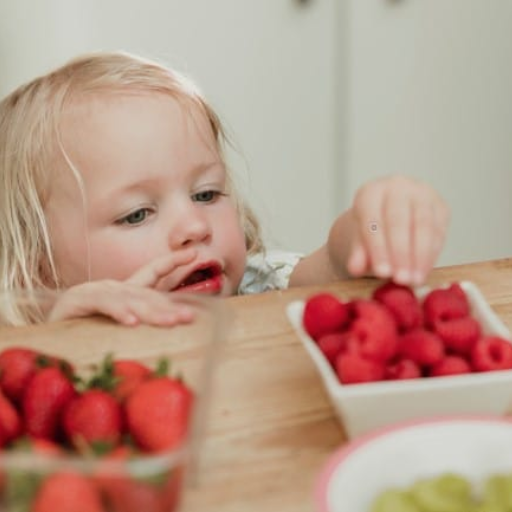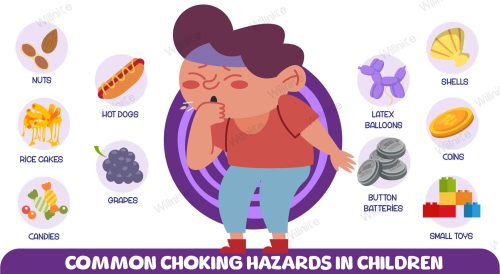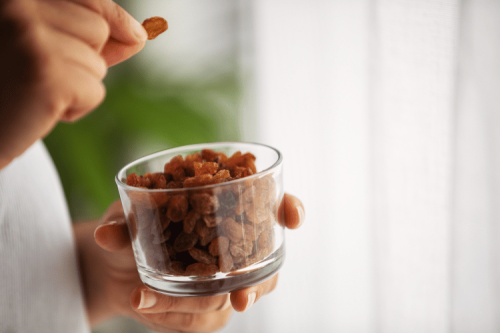
Choking is still a common threat when it comes to pediatric care and can even be fatal. This establishes a demand for more understanding and better mechanisms to keep children safe. This guide proceeds with the intention of enabling readers to appreciate the risk factors associated with choking, the preventive measures, and the emergency response practices that would help lessen this tendency among children. In relation to those topics, the aim of the present article is to provide assistance to caregivers, educators, and health professionals who work with kids by presenting them with key points related to food safety practices, supervision practices, and first-aid practices. In relation to those points, the article will show how these practices should be adopted as part of one’s understanding so that practical activities pertaining to this common but preventable threat can be approached with the required level of preparedness.

 Effective choking prevention strategies, in the opinion of a professional, include education, attention, and reform of the home environment. How feasible is the problem of choking? This can be answered with the first two questions: effective management and the creation of educational and preparative aspects of children’s feeding. Caregivers and parents need to be aware of the size, shape, and consistency of high-risk foods so that they can prepare meals that are appropriate for the age groups of children they’re catering to. Strategies for the supervision of children`s feeding or mealtime practices should be developed and consistently employed as children are able to eat safely in a relaxed and focused atmosphere with little disturbances. Children don’t carve out small objects in the feeding space, which creates choking hazards and requires routine inspections in every room of the house. Learning how to deal with the public in choking situations, including the need to perform first aid, emphasis on the performance of CPR, and Heimlich, especially for caregivers, need to be learned in order to be ready for a real-life choking event. Such practices should cut the chances of children experiencing choking incidents.
Effective choking prevention strategies, in the opinion of a professional, include education, attention, and reform of the home environment. How feasible is the problem of choking? This can be answered with the first two questions: effective management and the creation of educational and preparative aspects of children’s feeding. Caregivers and parents need to be aware of the size, shape, and consistency of high-risk foods so that they can prepare meals that are appropriate for the age groups of children they’re catering to. Strategies for the supervision of children`s feeding or mealtime practices should be developed and consistently employed as children are able to eat safely in a relaxed and focused atmosphere with little disturbances. Children don’t carve out small objects in the feeding space, which creates choking hazards and requires routine inspections in every room of the house. Learning how to deal with the public in choking situations, including the need to perform first aid, emphasis on the performance of CPR, and Heimlich, especially for caregivers, need to be learned in order to be ready for a real-life choking event. Such practices should cut the chances of children experiencing choking incidents.
 the most useful strategies for preventing choking are the avoidance of the situation and anticipation. The basis for preventive efforts is information – it is important to inform an adult guardian of hazards that may be posed by foods suitable for the child’s age. An important step in curbing risks is the creation of structured environments in which meals are eaten in secluded areas. Consistently examining and baby-proofing areas where children are likely to be within reach of small and easily swallowable objects is crucial. Also, educating caregivers about and providing them with precise aiding actions like the Heimlich technique ensures that immediate preventive measures are taken during distressing situations. These measures, when applied in the proper contexts, are able to minimize all instances and risks of choking.
the most useful strategies for preventing choking are the avoidance of the situation and anticipation. The basis for preventive efforts is information – it is important to inform an adult guardian of hazards that may be posed by foods suitable for the child’s age. An important step in curbing risks is the creation of structured environments in which meals are eaten in secluded areas. Consistently examining and baby-proofing areas where children are likely to be within reach of small and easily swallowable objects is crucial. Also, educating caregivers about and providing them with precise aiding actions like the Heimlich technique ensures that immediate preventive measures are taken during distressing situations. These measures, when applied in the proper contexts, are able to minimize all instances and risks of choking.
 Children with specific eating limitations have been diagnosed with different special health issues, and for them, the risk of choking while eating might be a frequent occurrence. Measures aimed at the prevention of choking in children with special needs should be effective at all levels, namely primary, secondary, and tertiary prevention measures. In order to minimize these risks, parents should manage feeding by placing smaller amounts of food into their mouths while cutting it into smaller bite-size portions prior to presenting it to the child. We are also going to organize swallowing assessment tests with our patients and modify their diets until we feel able to safely progress with exercise or therapy. There are children’s toys and small objects, such as straws and paper clips, which are extremely hazardous for kids with special needs. Such cost-effective approaches will enable us to decrease the level of risk associated with routine eating in children with developmental issues.
Children with specific eating limitations have been diagnosed with different special health issues, and for them, the risk of choking while eating might be a frequent occurrence. Measures aimed at the prevention of choking in children with special needs should be effective at all levels, namely primary, secondary, and tertiary prevention measures. In order to minimize these risks, parents should manage feeding by placing smaller amounts of food into their mouths while cutting it into smaller bite-size portions prior to presenting it to the child. We are also going to organize swallowing assessment tests with our patients and modify their diets until we feel able to safely progress with exercise or therapy. There are children’s toys and small objects, such as straws and paper clips, which are extremely hazardous for kids with special needs. Such cost-effective approaches will enable us to decrease the level of risk associated with routine eating in children with developmental issues.
 One of the reasons that children under 5 years of age present in emergency facilities is choking, which explains why so many children die each year in the emergency department. There is a high risk of obstruction due to the imperfect swallowing techniques and immature chewing mechanisms of toddlers. Specific foods like nuts, grapes, popcorn, hot dogs and hard candies are inherently high-risk because they are so large and textured that they are more likely to cause complete airway blockage.. These risks can be aggravated further in children with special needs who may already have motor or sensory processing difficulties. Understanding these factors and adopting appropriate measures of safety could help in reducing this risk and improving child health in the future.
One of the reasons that children under 5 years of age present in emergency facilities is choking, which explains why so many children die each year in the emergency department. There is a high risk of obstruction due to the imperfect swallowing techniques and immature chewing mechanisms of toddlers. Specific foods like nuts, grapes, popcorn, hot dogs and hard candies are inherently high-risk because they are so large and textured that they are more likely to cause complete airway blockage.. These risks can be aggravated further in children with special needs who may already have motor or sensory processing difficulties. Understanding these factors and adopting appropriate measures of safety could help in reducing this risk and improving child health in the future.
What Are the Leading Causes of Choking in Young Children?

Leading Causes of Choking in Young Children
The primary cause of suffocation in children is the accidental swallowing of pieces of food or tiny pet items that are firm and compact enough to fill up the airway. Certain nut types, grapes, hotdogs, popcorn, and hard candy rank high on the choking hazard list due to their physical dimensions, shape, texture, or other anatomical characteristics that are easily lodged in a child’s airway. Small parts of plastic toys, buttons, batteries, and coins can also have detrimental effects, particularly on infants and toddlers who explore their surroundings by mouthing everything they see. Lack of a developed chewing mechanism and incomplete nervous control of the swallowing mechanism aggravate these problems; hence, correct food types and the supervision of children are very vital so as to prevent choking episodes.Common Choking Hazards in the Household
I would like to point out that the family room has so many choking hazards that it is quite suitable for young kids. Common objects may be small toys, separate pieces of bigger play sets, coins or buttons, I have learned through my experience that people do sponsor these things although they have a recognized potential risk. Then there are nuts, seeds, raw pieces of vegetables, and even some food items, which have a higher risk, especially when adults are not supervising them, and they are found in places like kitchens. Parents or child guardians should be very careful and inspect playing and living environments on a regular basis for these dangers. Choking incidences in a family unit can greatly be reduced by the simple measures of evacuating or drawing heavy small objects and dividing food items into smaller bite-size portions.The Role of Food Choking in Childhood Incidents
Principally concerned about security, children have spent years studying how other children mesh well with food. I must state that inadequate safety supervision is a contributing factor to the child's choking situation. Let us fully consider this through stages:- Size and Shape of Food: Unfortunately, small foods which can be easily taken into a child’s airway like round hot dogs or nuts, or hard candies like grapes that get lodged into a child’s airway pose a danger. These kinds of foods need to be sliced into smaller portions so that the risk is managed.
- Texture and Consistency: Sticky food such as peanut butter or marshmallows can cause a blockage if not chewed well. Young children, the most-risk group, should be closely monitored when eating these objects.
- Swallowing Development: Swallowing and chewing mechanisms are under-developed in younger children. That’s why, some may consider disallowing children from eating potentially harmless foods as a solution, but these foods can similarly lead to seeking difficulties because of their inability to consume them properly.
- Supervision and Eating Habits: When children are busy running, playing, or laughing with food in their mouth, they are even more likely to choke. Therefore, helping them establish a conducive environment and eating arrangement such as not being distracted or losing their mind can be of great help.
- Age-Appropriate Foods: Foods need to be given to children according to their age and the level of development that has been reached. For instance, in the case of toddlers, not providing whole nuts or hard candies can change the dynamics greatly by preventing exposing children to unnecessary risks.
Infants and Young Children: Why They Are at Greater Risk
it is essential to find out why infants and young children are more likely to choke. Let me provide you with the major elements:- Developmental Stage: Due to the fact that infants and young toddlers are still learning to chew and swallow, their motorial components are not yet highly developed. Hence, this makes it hard for them to be able to handle various sizes or textures of food that older children and adults would find easy.
- Airway Size: The size of young airway passages is smaller than that of adults. This feature places an increased choking risk on children, as even small parts of food can block the airways quite easily.
- Natural Curiosity: The children in this age range are in the curiously inclined phase of taste and touch explorations of their surroundings. Unsurprisingly, this leads children to an increased likelihood of putting both edible and inedible objects in their mouths, which increases the chances of swallowing choking hazards.
- Lack of Supervision Awareness: Children at such tender ages are not able to comprehend the safety risks posed by small objects and certain foods. With no supervision, they may randomly attempt to eat something without chewing enough of it, or eat while engaged in other activities, like playing, which may heighten the risk of choking.
- Physical Activity While Eating: Infants and toddlers are generally very active and cannot sit still during mealtimes, thus if these young children eat while laughing or moving about then there is the risk of choking.
How Can Choking Prevention Be Implemented Effectively?
 Effective choking prevention strategies, in the opinion of a professional, include education, attention, and reform of the home environment. How feasible is the problem of choking? This can be answered with the first two questions: effective management and the creation of educational and preparative aspects of children’s feeding. Caregivers and parents need to be aware of the size, shape, and consistency of high-risk foods so that they can prepare meals that are appropriate for the age groups of children they’re catering to. Strategies for the supervision of children`s feeding or mealtime practices should be developed and consistently employed as children are able to eat safely in a relaxed and focused atmosphere with little disturbances. Children don’t carve out small objects in the feeding space, which creates choking hazards and requires routine inspections in every room of the house. Learning how to deal with the public in choking situations, including the need to perform first aid, emphasis on the performance of CPR, and Heimlich, especially for caregivers, need to be learned in order to be ready for a real-life choking event. Such practices should cut the chances of children experiencing choking incidents.
Effective choking prevention strategies, in the opinion of a professional, include education, attention, and reform of the home environment. How feasible is the problem of choking? This can be answered with the first two questions: effective management and the creation of educational and preparative aspects of children’s feeding. Caregivers and parents need to be aware of the size, shape, and consistency of high-risk foods so that they can prepare meals that are appropriate for the age groups of children they’re catering to. Strategies for the supervision of children`s feeding or mealtime practices should be developed and consistently employed as children are able to eat safely in a relaxed and focused atmosphere with little disturbances. Children don’t carve out small objects in the feeding space, which creates choking hazards and requires routine inspections in every room of the house. Learning how to deal with the public in choking situations, including the need to perform first aid, emphasis on the performance of CPR, and Heimlich, especially for caregivers, need to be learned in order to be ready for a real-life choking event. Such practices should cut the chances of children experiencing choking incidents.
Prevention Tips for Parents and Caregivers
I acknowledge that the home poses a considerable risk for choking hazards. In light of this, I have structured the following guidelines to help you protect your children:- Understand High-Risk Foods: Foods such as grapes, hot dogs, and nuts pose a risk of choking. Always cut these foods into smaller pieces to increase the safety of young children.
- Maintain Supervision: Children should not eat without adult supervision. It is suggested that the eating environment be relaxed and free from disturbances so that the chances of choking are minimised.
- Promote Proper Eating Habits: Parents should teach their children not to speak or entertain with food in their mouth and to chew and swallow properly. This would reduce the chances of choking.
- Age-Appropriate Food Selection: Adapt food choices according to the child’s stage of development. Banana slices, or well-cooked, mashed vegetables would be safe for toddlers.
- Educate on Emergency Response:, Hope for the Best: Basic emergency skills such as the practices involved in the Heimlich maneuver should be learnt. As these skills can often enable life rescuing situations.
- Childproof Living Areas: The parents try to find out whether or not small objects such coins or small toy parts are still in the lower drawers. In case they get loose, they may be swallowed by children.
Understanding the Airway and Its Importance
Comprehending the airway is fundamental when addressing the issue of choking prevention, especially in the target population of infants and young children. Let us look at a simpler dissection, which puts the important components into perspective:- Anatomy of the Airway: An airway is a channel through which the air enters and leaves the lungs. In kids, it is narrow than in adults which is why broccoli or any small food can turn into disaster quite easily.
- Role of the Epiglottis: This tongue part protects the trachea when eating, allowing food to reach the stomach. But because this construct is immature in children, food going into the trachea might create choking since the coordination is poor.
- Importance of the Trachea: This windpipe is vital in allowing air to go in and out of the lungs. Blockage in this region will restrict normal breathing, and this should be corrected urgently; hence, there is a need to react quickly to choking.
- Development of Swallowing Abilities: Young kids are still losing teeth; hence, chewing is not fully developed. The infants do not have control of this system; thus, the likelihood of food being sucked into their airways is increased.
- Vigilance in Supervision: Anatomically and developmentally, kids are very prone to getting choked therefore, there must be very close attention relation to what there are doing during feeding. This lets the caregiver respond to possible events of choking and take appropriate action.
Creating a Safe from Choking Environment
The first step that I adopt is designing the interior of the home in a way that makes it less likely for choking to happen. Such inedible items should not be in reach of children, and all kinds of meals should be eaten only at a designated time and place so that a high level of order is maintained. Children’s food is not only cut into baby-sized portions, but I also take into consideration their proper developmental stages with regard to what foods can be introduced and when. Apart from that, I try to explain the motion of choking to my family members in order to help them understand the importance of these measures, which in turn make them more responsible. Moreover, I regularly check toys and various items around the house which may fall into children's hands and may be within their reach to prevent such situations. Such an approach ensures that choking risks are kept to a minimum and children are free to play about without any risks of ingesting objects.What Are the Most Effective Choking Prevention Techniques?
 the most useful strategies for preventing choking are the avoidance of the situation and anticipation. The basis for preventive efforts is information – it is important to inform an adult guardian of hazards that may be posed by foods suitable for the child’s age. An important step in curbing risks is the creation of structured environments in which meals are eaten in secluded areas. Consistently examining and baby-proofing areas where children are likely to be within reach of small and easily swallowable objects is crucial. Also, educating caregivers about and providing them with precise aiding actions like the Heimlich technique ensures that immediate preventive measures are taken during distressing situations. These measures, when applied in the proper contexts, are able to minimize all instances and risks of choking.
the most useful strategies for preventing choking are the avoidance of the situation and anticipation. The basis for preventive efforts is information – it is important to inform an adult guardian of hazards that may be posed by foods suitable for the child’s age. An important step in curbing risks is the creation of structured environments in which meals are eaten in secluded areas. Consistently examining and baby-proofing areas where children are likely to be within reach of small and easily swallowable objects is crucial. Also, educating caregivers about and providing them with precise aiding actions like the Heimlich technique ensures that immediate preventive measures are taken during distressing situations. These measures, when applied in the proper contexts, are able to minimize all instances and risks of choking.
First Aid Measures for Choking Incidents
Choking situations can be managed by quick action as well as knowing the correct procedure. Here, in this regard, we will outline the essential first aid measures with sufficient instructions and data that can help in effective response:- Assess the Situation:
- Start by identifying if the individual can cough, shed tears or verbalize words. In case, any of these activities are possible, it implies that there is still hope of recovery without complete occlusion of the airway. Advise that they try and force out the cough.
- According to preliminary scientific work carried out to establish the norms in the medical field, it came out that obstructions due to foreign objects tend to get self-cured due to the natural action of cough.
- Heimlich Maneuver (Abdominal Thrusts) for Adults and Children Over 1 Year:
- Position yourself behind the victim, then secure his/her body by holding his/her waist.
- Clench one fist place it slightly above the umbilicus, and clasp it with the other hand.
- To help the person remove the substance in question, apply several rapid jerks directed upwards until the substance is expelled or the patient begins to cough or respire.
- The researchers say that in more than 70% of dislodgement of foreign bodies from adults and older children the Heimlich maneuver succeeds.
- Back Blows and Chest Thrusts for Infants:
- When caring for infants below 1 year of age, lay the baby across the forearm while supporting its head and neck in the process of its removal.
- Between the shoulder blades of the infant, deliver four to five forceful blows with the heel of the hand.
- If the infant fails to expel the object, rotate him/her over and perform a sequence of chest thrusts using two fingers in the middle area of the chest for a maximum of five repetitions.
- Studies suggest that the simultaneous application of back blows and chest thrusts is the best practice in case of choking incidents in infants.
- Ensure Continuous Airway Monitoring:
- Observe the individual for the respiratory rate and depth, the quantity of cough,h, and level of consciousness.
-
Any obstruction that does not displace with time requires professional medical help immediately.
- Seek Emergency Medical Help:
- Should the blockage remain, and the person is unable to ventilate or becomes unconscious, the nearest medical center should be contacted at once.
-
Statistics record that near-fatal choking episodes are less often fatal when medical help is rendered timely and appropriately.
When to Seek Help from a Pediatrician
I consider it my duty to advise parents to contact a pediatrician if they observe particular symptoms that they feel are unreasonable. Here is the most important patient’ evidence that require specialist advice:- Persistent Difficulty Breathing: If the child develops a difficulty in breathing which is not relieved by the initial first aid measures, it is important to get in touch with a pediatrician. Breathing with difficulty may mean that, that the airway remains partly obstructed, and medical assistance is warranted.
- Recurrent Choking Episodes: Where the child suffers choking recurrently, it may suggest an underlying problem, such as a swallowing disorder, requiring referral to a specialist for more in-depth assessment.
- Coughing or Wheezing that Doesn't Subside: Following a chocking event, observe your child for any coughing or wheezing which are common to the children during and after the event but should not persist. This could indicate that an object is still trapped in the air passage or that some damage has been done to the respiratory structures.
- Changes in Behavior or Level of Awareness:Any major departure from the child’s normal behavior or level of awareness, for example, excessive drowsiness, or irritability, in children after a choking episode, should be brought to the attention of a pediatrician.
- Lack of Improvement with Initial First Aid: If the initial response to a choking episode fails to produce the desired effect and the child’s condition does not improve in a short time or when the object cannot be easily removed, then the patient has to be taken to the nearest healthcare facility without any delay.
How to Identify Nonfatal Choking Episodes
my intention is to present a simple technique for understanding episodes of nonfatal choking in children. Being well-educated on these episodes it entails an appreciation of specific signs and parameters:- Observation of Sudden Coughing or Gagging: In cases where a child is in the midst of an activity such as eating or chewing on small objects, Reichman saught ends up in a cough or gag reflex; this cough reflex is known as a choking episode in most people, and it is essential in clearing the airway.
- Audible Wheezing or High-Pitched Breathing Sounds: Does the child breathe in any wheezing, loud noises or high pitched sounds when taking in breath? This indicates that there is a mild blockage of the airway and needs attention.
- Changes in Skin Color: There is a need to watch whether the color of the skin around children’s mouth, fingers, and toes changes from normal to a shade of blue or white, as such changes indicate that there is blockage to some extent in the airway, and especially to the flow of oxygen.
- Difficulty Speaking or Crying: In cases where children who are upset and desire to cry but suddenly fail to do so, there could be a potential threat to the airway, which could be dangerous.
- Panic or Frantic Behavior: Note also the signs of physical panic, if there are any; children could point their hands towards their neck and move their body in an anxious manner whilst trying to find out the problem.
- Ineffective Coughing: This means that the child is unable to cough properly for effective clearing of the airways. In such cases, help may need to be rendered in order to dislodge the object that is stuck in the child’s airway.
How Can We Protect Children with Special Needs from Choking?
 Children with specific eating limitations have been diagnosed with different special health issues, and for them, the risk of choking while eating might be a frequent occurrence. Measures aimed at the prevention of choking in children with special needs should be effective at all levels, namely primary, secondary, and tertiary prevention measures. In order to minimize these risks, parents should manage feeding by placing smaller amounts of food into their mouths while cutting it into smaller bite-size portions prior to presenting it to the child. We are also going to organize swallowing assessment tests with our patients and modify their diets until we feel able to safely progress with exercise or therapy. There are children’s toys and small objects, such as straws and paper clips, which are extremely hazardous for kids with special needs. Such cost-effective approaches will enable us to decrease the level of risk associated with routine eating in children with developmental issues.
Children with specific eating limitations have been diagnosed with different special health issues, and for them, the risk of choking while eating might be a frequent occurrence. Measures aimed at the prevention of choking in children with special needs should be effective at all levels, namely primary, secondary, and tertiary prevention measures. In order to minimize these risks, parents should manage feeding by placing smaller amounts of food into their mouths while cutting it into smaller bite-size portions prior to presenting it to the child. We are also going to organize swallowing assessment tests with our patients and modify their diets until we feel able to safely progress with exercise or therapy. There are children’s toys and small objects, such as straws and paper clips, which are extremely hazardous for kids with special needs. Such cost-effective approaches will enable us to decrease the level of risk associated with routine eating in children with developmental issues.
Special Considerations for Children with Special Needs
My knowledge assures me that the process of nurturing children with special needs should be thoroughly customized to individuality. Concerning the risk posed by choking and assuring their well-being, this is how we could go about it:- Customized Feeding Strategies: This one is quite simple: feeding practices need to change. I suggest that food served to them should be cut up into small pieces, and mealtimes should be observed in order to assess the child’s ability to chew and swallow appropriately.
- Utilization of Adaptive Feeding Tools: Tools and devices such as adaptive cutlery and specially designed drinking cups often yield good results. These are meant to help in coping with particular adverse muscle controls and enhance safety and comfort of feeding.
- Regular Swallowing Assessments: Health professionals should evaluate your child’s swallowing capacity from time to time, and this should be done in a clinical setting. They can provide specific educational and therapeutic actions to promote these abilities.
- Supervision and Assistance during Meals:When a child is feeding, supervision and help should be provided to manage potential problems effectively. Being around helps since immediate help can be provided when a child has a swallowing problem.
- Safe Environment Maintenance: It is important to keep the area clear of small articles or toys which may be a choking risk. This means that spaces designated for play should be inspected on a regular basis and all risk factors removed.
- Communication with Healthcare Providers: It is also very helpful to maintain communication with the healthcare professionals responsible for your child so that they should be able to care for every possible risk comprehensively and continuously.
Adapting Choking Prevention Strategies
In order to reduce the chances of choking, particularly in children who have special needs, making precise modifications in the surroundings and their routine is vital. In more straightforward terms, here’s how we can go about doing this:- Size and Shape of Food: It is always advisable to give food to children of small sizes which allow them to chew easily and quickly. Foods like grapes, hot dogs and nuts which are rounded or very chewy should be avoided as they can block their wind pipes.
- Supervised Eating:Adults should always be there during meals to observe how the child is eating and eating. This presence ensures immediate action will be initiated if the child has difficulty with swallowing or outages the need to either vomit or cough in an embarrassing situation.
- Adaptive Tools: These children need adaptive cutlery or cups to help them feed themselves. They have a large variety of uses and can be extremely beneficial for young children with motor control difficulties.
- Regular Swallowing Check-ups: Make it a point to have regular assessments with the health care providers to evaluate the child’s swallowing ability. There are various forms of treatment that these professionals will provide which include exercises to make their swallowing safe during meals.
- Safe Environment: Remove small toys and other small objects from the child’s surroundings that can be easily swallowed. Areas used for play should be routinely checked so it can be guaranteed that only safe items are within reach.
- Communication: Make sure to update healthcare professionals on your child’s developments as well as your worries, so that care plans can be updated and further assistance can be offered.
Resources and Support for Pediatrician Guidance
It is possible to create a favorable environment where caregivers practice their ‘talk and care’ strategies to prevent choking for children with a combination of resources and assistance. Elementary indicates enhancing their professional skills through training and seminars about the problems caused by choking in children. Specialized feeding devices and appliances that are related to particular motor impairment or developmental issues should be available. It is important for pediatricians to create strong links with speech and language therapists, occupational therapists, and dieticians who can assist in formulating and implementing holistic care plans. Also, it is possible to improve the management and therapeutic processes through the application of research evidence-based clinical practice guidelines and taking part in team-based management consultations. Regular transfer of information between caregivers and the child or the child's health team is important in changing the approaches to suit the child’s current development status in a consistent way to ensure choking risk is minimized.What Role Does Choking on Food Play in Injury and Death Among Children?
 One of the reasons that children under 5 years of age present in emergency facilities is choking, which explains why so many children die each year in the emergency department. There is a high risk of obstruction due to the imperfect swallowing techniques and immature chewing mechanisms of toddlers. Specific foods like nuts, grapes, popcorn, hot dogs and hard candies are inherently high-risk because they are so large and textured that they are more likely to cause complete airway blockage.. These risks can be aggravated further in children with special needs who may already have motor or sensory processing difficulties. Understanding these factors and adopting appropriate measures of safety could help in reducing this risk and improving child health in the future.
One of the reasons that children under 5 years of age present in emergency facilities is choking, which explains why so many children die each year in the emergency department. There is a high risk of obstruction due to the imperfect swallowing techniques and immature chewing mechanisms of toddlers. Specific foods like nuts, grapes, popcorn, hot dogs and hard candies are inherently high-risk because they are so large and textured that they are more likely to cause complete airway blockage.. These risks can be aggravated further in children with special needs who may already have motor or sensory processing difficulties. Understanding these factors and adopting appropriate measures of safety could help in reducing this risk and improving child health in the future.
Statistics on Choking Incidents and Outcomes
According to statistics, and as a profession, children choking is such a common occurrence — which I would like to explain, however, first, let me answer the question that says how often such incidents occur and what their average outcome is. Most children under the age of four are prone to choking on various objects, but the exact number is not known.- Prevalence: Based on the national clinical records, leading uses for emergency departments due to injury include strangulation. Children under the age of five are often choking for food and non-food items and resorting to this behavior even when those needing medical attention are most often a result of food-related chewing difficult to prevent from occurring often. The importance of close observation of children throughout instruction and eating is self-evident.
- Common Culprits: The most common foods that pose a child choking risk include; hard candies, nuts, grapes, hot dogs, and String cheeses. Each of these foods has some special properties that when combined make them quite dangerous in size, shape or texture. It is therefore advisable to cut up or quarter food and to remove high risk foods to reduce the risk of injury in children.
- Outcomes: Research shows that for most unattended choking victims, the episode often does not amount to a great catastrophe or where time loads onto the nose or mouth, patients survive without first alarmist, but statistics show that those caused two hundred percent of admission together with one more case at the afterward and with few results later years only cases have already arisen emerged. Until help arrives, individuals must maintain a healthy balance between moderate anxiety and extreme panic.
- Risk Factors: The age of the child and the offending factors, such as eating habits and stage of development, are paramount. For toddlers and those with special needs, the environment must be modified to accommodate their additional risks, so extra precautions should be taken.
Understanding the Leading Cause of Such Incidents
Now, as an industry expert, let us look at the risk factors that lead to childhood choking episodes in a very uncluttered manner. In order to comprehend fully the causes, however, it is important to take into consideration a number of relevant parameters, which are:- Developmental Stage: Kids younger than five are more susceptible to vice choking since most kids of this age have not efficiently developed proper chewing and swallowing skills. It is a phase when children are still grasping the skills and controlling food within their mouths, thus increasing chances of blockages.
- Food Characteristics: Choking Mostly occurs with some types of foods that are exactly of a certain shape and texture, making a perfect fit to block the airway tract. Foods such as hot dogs, nuts and grapes, or any other firm foods easily get stuck in the child’s throat, increasing the risk with hard candies.
- Eating Habits: Eating quickly or without focus on the food can also be a factor in causing choking. Kids tend to swallow food without adequate chewing when they to eat when playing or laughing and this increases the risk of food getting lodged kids.
- Supervision: First and foremost the absence of an adult in the house during meal times is a factor of foster choking. These children require repeated reminders against talking with food still in their mouth and also cells to be chewing food properly.
- Special Needs:In the case of children with motor skill or sensory processing challenges, there may also be certain additional choking risks. Precautions tailored towards these needs as well as specialized tools can be necessary for safety during mealtimes of such children.
Strategies to Prevent Choking in Children Younger than 10 Years
As someone specializing in the given industry, it is important to note that preventive coordination choking in children below ten years of age. The first step should be to change both the surroundings and the habits of people to reduce risk. In this regard, here are brief and practicable guidelines developed on the basis of evidence:- Modify Food Sizes and Textures: Cut or mush high-risk foods such as grapes, hotdogs, etc into little bits or easy mess for children. Don’t give very small children hard candy, nuts and other foods which would be difficult to chew or swallow.
- Establish Meal-Time Rules: Encourage children to remain seated at the table while eating. Encourage children to chew their food before swallowing. Do not allow children to talk, laugh and play while they are eating as it is likely to increase the risk of choking.
- Supervision: An adult should always be present at all mealtimes to supervise children. Make sure the caregivers are well versed on the management of emergency including the use of heimlich maneuver as one of the choking emergencies.
- Adaptation for Special Needs: Specialized tools and techniques of feeding should be encouraged among children with special needs as advised by the health care providers. Modify feeding techniques to suit individual needs so as to maximize safety.
- Education and Training: Periodically all caregivers, parents and teachers-in particular, should be educated and trained on the risk factors and preventive measures of choking. Educate and empower them in safeguarding the healthy environment during feeding.
Reference
- Prevention of choking among children - This article discusses comprehensive and coordinated prevention strategies for childhood choking hazards.
- Assessing school‐based intervention strategies to foster the prevention of choking injuries in children: The results of the CHOP (CHOking Prevention) trial - This study evaluates the effectiveness of school-based intervention strategies for preventing food choking injuries in children.
- Preventing choking and suffocation in children - This article provides information on choking and suffocation prevention for childcare providers and babysitters.
Frequently Asked Questions (FAQs)
Q: What are the top tips to prevent a child from choking?
A: To prevent a child from choking, always supervise them during meals, cut foods like whole grapes into small pieces, avoid giving sticky candy, and ensure toys with small parts are out of reach. The American Academy of Pediatrics also recommends teaching older siblings about the importance of child safety.Q: What foods pose a risk for choking among young children?
A: Foods that pose a risk for choking include whole grapes, sticky candy, nuts, popcorn, and hot dogs. It's important to cut food into small, manageable pieces for infants and children, especially those 4 years of age and younger.Q: How common is choking among children in the United States?
A: Choking is a significant concern, with the disease control and prevention statistics indicating that approximately 77 children younger than 10 die from choking on food each year in the United States.Q: How can toys become choking hazards for children?
A: Toys with small parts, small balls, and latex balloons are common choking hazards for children. It's essential to follow age recommendations on toy packaging and regularly inspect toys for damage that could create small, detachable pieces.Q: What should I do if a child is choking?
A: If a child is choking, call emergency services immediately. Follow first aid procedures such as back blows and abdominal thrusts for children over 1 year of age. For infants, back blows and chest thrusts are recommended. Learning cardiopulmonary resuscitation (CPR) is also beneficial.Q: Are certain children more vulnerable to choking risks?
A: Yes, infants and children 4 years of age and younger are particularly vulnerable to choking risks due to their smaller airways and tendency to explore objects with their mouths.Q: How can I ensure poison prevention in my home?
A: To ensure poison prevention, store medicines and household chemicals out of reach of children, use child safety locks on cabinets, and educate children about the dangers of ingesting unknown substances.Q: How often does a child die from choking?
A: Tragically, a child dies from choking approximately every five days in the United States, highlighting the importance of awareness and prevention measures.Q: What role does the American Academy of Pediatrics play in preventing choking and ensuring child safety?
A: The American Academy of Pediatrics provides guidelines and resources for preventing choking and ensuring child safety, including recommendations on proper food preparation and safe toy selection.1575








 Login with Google
Login with Google Login with Facebook
Login with Facebook